Meade LS-8 ACF, LS-8 SC, LS-6 ACF, LS-6 SC User Manual
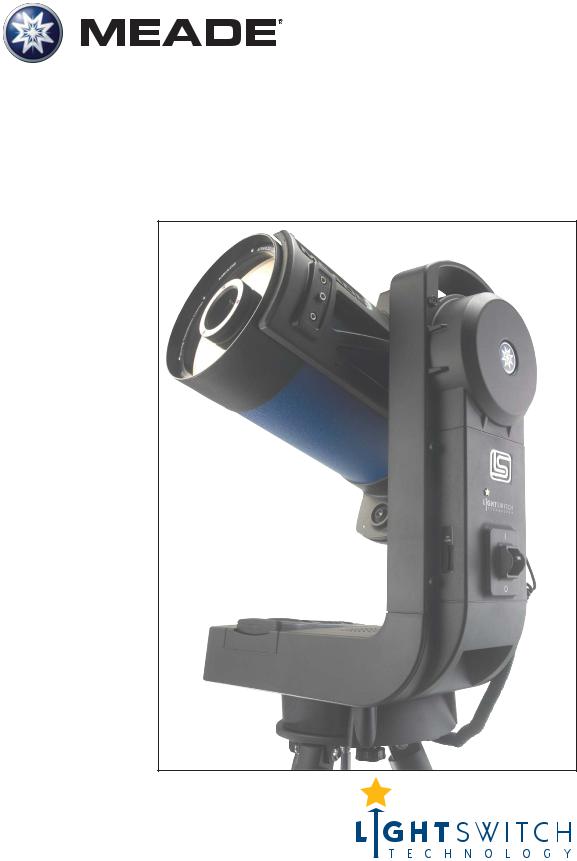
Instruction Manual
6" LS-6 ACF / 6" LS-6 SC and
8" LS-8 ACF / 8" LS-8 SC Telescopes with AutoStar III Hand Controller Firmware version 1.3 and higher
INDEX 

 WARNING!
WARNING!
Never use a Meade® LS™ Telescope to look at the Sun!
Looking at or near the Sun will cause instant and irreversible damage to your eye. Eye damage is often painless, so there is no warning to the observer that damage has occurred until it is too late. Do not point the telescope at or near the Sun. Do not look through the telescope or Red-Dot Finder as it is moving. Children should always have adult supervision while observing.
 INDEX
INDEX 
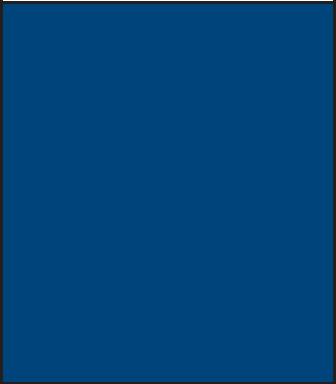
CONTENTS
Introduction
The most sophisticated and easiest
to use telescope ever . . . . . . . . . . . . . . . . . . . . . . . .3
Getting Started
Assembling the Telescope and using LightSwitch
Assembling the tripod . . . . . . . . . . . . . . . . . . . . . . . .5 Mounting the tripod . . . . . . . . . . . . . . . . . . . . . . . . . .6 Installing the batteries . . . . . . . . . . . . . . . . . . . . . . . .6 Using an AC Adapter or DC Power Cord . . . . . . . . .6 Attaching Accessories. . . . . . . . . . . . . . . . . . . . . . . .7 Telescope is now Fully Assembled . . . . . . . . . . . . . .7 Powering up the Telescope - LightSwitch Technology™ . . . . . . . . . . . . . . . . . . . . . . . . . . . . . .8
AutoStar III Handbox – Basic Usage
Basics . . . . . . . . . . . . . . . . . . . . . . . . . . . . . . . . . . . .9 Navigating the Menus . . . . . . . . . . . . . . . . . . . . . . . .9 Changing Modes. . . . . . . . . . . . . . . . . . . . . . . . . . .10 Menu Mode . . . . . . . . . . . . . . . . . . . . . . . . . . . . . . .10 Scope Info Mode. . . . . . . . . . . . . . . . . . . . . . . . . . .10 Sky Map Mode . . . . . . . . . . . . . . . . . . . . . . . . . . . .10 Shortcuts. . . . . . . . . . . . . . . . . . . . . . . . . . . . . . . . .10
LS Key Features
Telescope
Key Features identified on the Telescope . . . . . . . . 11 Key Features Explained . . . . . . . . . . . . . . . . . . . . .13 Using the Red-Dot Finder . . . . . . . . . . . . . . . . . . . .15 Adjusting the Red-Dot Finder . . . . . . . . . . . . . . . . .15
Optional MEADE® Accessories
Choosing Eyepieces . . . . . . . . . . . . . . . . . . . . . . . .16 Meade Series 4000 Super Plössl Eyepieces . . . . .16 Meade Series 5000 Premium Eyepieces . . . . . . . .17 Power Supplies . . . . . . . . . . . . . . . . . . . . . . . . . . . .18 Imagers and related Accessories . . . . . . . . . . . . . .18
AutoStar III Handbox
Buttons, Display and their functions . . . . . . . . . . . .19 Menu Tree. . . . . . . . . . . . . . . . . . . . . . . . . . . . . . . .23 Guided Tour Menu. . . . . . . . . . . . . . . . . . . . . . . . . .24 Object Menu . . . . . . . . . . . . . . . . . . . . . . . . . . . . . .24 Event Menu. . . . . . . . . . . . . . . . . . . . . . . . . . . . . . .25 Take Picture Menu . . . . . . . . . . . . . . . . . . . . . . . . .25 Utilities Menu. . . . . . . . . . . . . . . . . . . . . . . . . . . . . .26 Setup Menu. . . . . . . . . . . . . . . . . . . . . . . . . . . . . . .27
Advanced LS Features
Two Star Alt Az Alignment . . . . . . . . . . . . . . . . . . . .29 One Star Alt Az Alignment. . . . . . . . . . . . . . . . . . . .30 Finding objects not in the database . . . . . . . . . . . .30
® The name “Meade,” “AutoStar”, “LightSwitch” and the Meade logo are trademarks registered with the U.S. Patent and Trademark Office and in principal countries throughout the world. “SmartFinder”, “Deep Sky Imager”, “LS”, and “Tonight’s Best” are trademarks of Meade Instruments Corporation.
Patents:
US 7,277,223, US 7,079,317, US 7,092,156
US 6,304,376, US 7,221,527, US 6,922,283 US 6,392,799
© 2009 Meade Instruments Corporation.
Landmarks . . . . . . . . . . . . . . . . . . . . . . . . . . . . . . .30 Observing Satellites . . . . . . . . . . . . . . . . . . . . . . . .31 Terrestrial Observing. . . . . . . . . . . . . . . . . . . . . . . .32
Maintenance
Basic Maintenance . . . . . . . . . . . . . . . . . . . . . . . . .33 Collimation . . . . . . . . . . . . . . . . . . . . . . . . . . . . . . .33 Inspecting the Optics. . . . . . . . . . . . . . . . . . . . . . . .35 Gauging the Movement of the Telescope . . . . . . . .35 Updating Your LS Firmware . . . . . . . . . . . . . . . . . .35 SD Card for Updates and Image Storage . . . . . . . .36
Meade Customer Service
How to get in contact. . . . . . . . . . . . . . . . . . . . . . . .36
Appendix A:
Training the Drive . . . . . . . . . . . . . . . . . . . . . . . . . .37
Appendix B:
Creating User Objects. . . . . . . . . . . . . . . . . . . . . . .38
Appendix C:
Basic Astronomy . . . . . . . . . . . . . . . . . . . . . . . . . . .39
Specifications
LS-6 ACF: . . . . . . . . . . . . . . . . . . . . . . . . . . . . . . . .41 LS-6 SC: . . . . . . . . . . . . . . . . . . . . . . . . . . . . . . . . .42 LS-8 ACF. . . . . . . . . . . . . . . . . . . . . . . . . . . . . . . . .43 LS-8 SC. . . . . . . . . . . . . . . . . . . . . . . . . . . . . . . . . .44
Declarations
FCC: . . . . . . . . . . . . . . . . . . . . . . . . . . . . . . . . . . . .45 WEEE:. . . . . . . . . . . . . . . . . . . . . . . . . . . . . . . . . . .46
Meade Warranty
One Year Limited Warranty . . . . . . . . . . . Back Cover
BATTERY SAFETY INSTRUCTIONS:
•Always purchase the correct size and grade of battery: 8 x “C-type” Alkaline batteries (ANSI 14A, 14AC/
IEC LR14).
•Always replace the whole set of batteries at one time, taking care not to mix old and new ones, or batteries of different types.
•Clean the battery contacts and also those of the device prior to battery installation.
•Ensure the batteries are installed correctly with regard to polarity (+ and -).
•Remove batteries from equipment which is not to be used for an extended period of time.
•Remove used batteries promptly.
•Never attempt to recharge primary batteries as this may cause leakage, fire, or explosion.
•Never short-circuit batteries as this may lead to high temperatures, leakage, or explosion.
•Never heat batteries in order to revive them.
•Remember to switch off devices after use.
•Keep batteries out of the reach of children; small batteries may be ingested.
•Seek medical advice immediately if a battery has
been swallowed.
Caution: If batteries or parts are swallowed, see a doctor immediately.
 INDEX
INDEX 
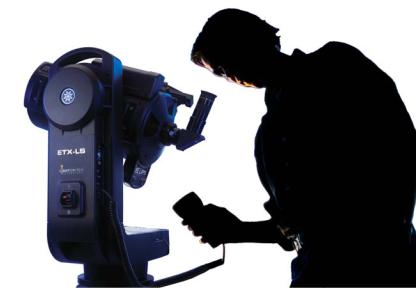
INTRODUCTION
The LS-6 and LS-8 LightSwitch® Telescopes
The most sophisticated and easiest to use telescopes ever
Congratulations on receiving your new LS telescope. You’ll find that this telescope system has all you need to explore the Universe we live in. Meade’s concept was to create a telescope that would be simple enough for anyone to use, yet capable enough for the experienced amateur to stretch their knowledge and skills. With the most advanced and complete list of features of any telescope, you will have plenty of room to learn and expand your interest in astronomy and not out grow your telescope. Here are a few of the features that set the Meade LS telescope system apart from all others.
Ease of Use: LightSwitch Technology is the ultimate in easy setup. Using a combination of optical, mechanical and electronic sensors, LightSwitch delivers a telescope ready to start observations without any input from the user.
Optics: Your choice of optical systems to meet your needs. Meade’s Schmidt-Cassegrain (SC) optics give you high performance for the best possible price. Water-white glass, Ultra-High Transmission Coatings (UHTC) and oversized, thermally-stable Pyrex® primary mirrors provide spectacular viewing experience not available on comparable competitors’ telescopes. Advanced Coma-Free takes all of the features of our SC models and then ups the ante. ACF gives a flatter, coma-free field of view with pinpoint images all the way to the edge of the field, equaling Ritchey-Crétien performance. ACF is the perfect solution for the serious astroimager or visual astronomer looking for observatory-class optics.
Mechanics: Strong and stable aluminum castings with large precision worm-gear drives in both axes for smooth tracking with low periodic error.
Computer: AutoStar III handbox gives you complete control of your LS system from the palm of your hand. With a database of nearly 100,000 objects, you will never run out of things to explore.
Multimedia: The Astronomer Inside™ provides audio and video descriptions of the objects you are viewing with a wealth of information along with guided tours of the best objects in your sky.
Imaging: The built-in ECLIPS™ CCD Module enables you to take wide-field digital images of the sky, view them real time with an attached video monitor and save them to an SD card without using and external computer.
If you are like us, you can’t wait to get outside under a dark sky to try out your new LS telescope. We have provided a Getting Started Guide that will get you up and running in the shortest amount of time possible. After your first experience, please sit down with this manual and read about all the advanced features that are available to you with this telescope system. We are confident that the LS will keep you fascinated with the Universe and entertained for many years to
Clear Skies,
The people at Meade
 INDEX
INDEX 
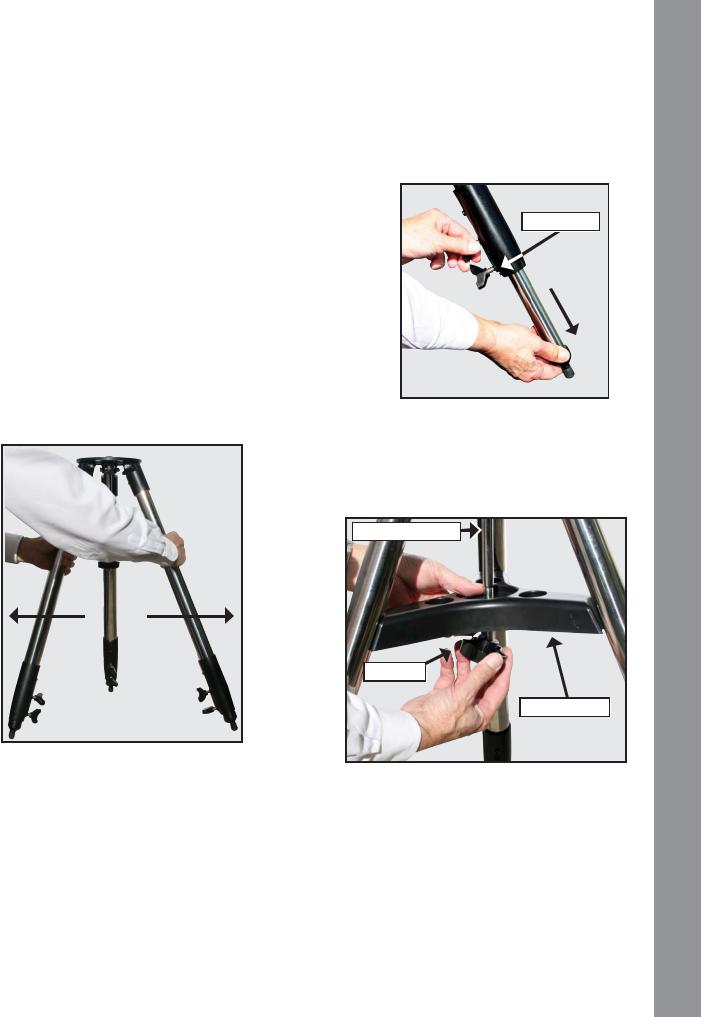
GETTING STARTED
You may want to perform the LS assembly indoors in the light so that you become familiar with the parts and operation before moving the telescope outside into the dark for observing. This Getting Started Guide assumes you are too impatient to read the entire manual first and want to use your new telescope as quickly as possible. Just follow the simple steps below and you will be up and running before you know it.
It is best to set up the telescope in twilight or before sunset the first time you use it. Take the telescope and tripod outside. Set the telescope in a large open area where you can see lots of sky. Don’t setup right next to a building or a wall. Also try to stay away from large metal objects like a car or a metal fence. Make sure the ground is stable and is approximately level. It is best to set up the scope away from bright nighttime lighting. Bright lights will spoil your night vision and impede your ability to see the sky. Additionally, it will take the telescope longer to align itself if there are too many bright lights around.
Assembling the Tripod
Remove the field tripod from the shipping carton. Stand the tripod vertically with the tripod feet down and with the tripod still fully collapsed. Grasp two of the tripod legs and, with the full weight of the tripod on the third leg, gently pull the legs apart to a fully open position.
Lock-Knob
Thread in two lock-knobs on each leg (six total) near the foot of each tripod leg. Use the lock-knobs to vary the height of the inner, extendible tripod leg sections. Tighten the locks to a firm feel only; do not overtighten.
Spreader Shaft
End Nut
Spreader Bar
Remove the end nut from the spreader shaft and slide the spreader in between the telescope legs. Attach the end nut and hand tighten until the telescope legs are held snuggly in the most spread position. Position the tripod where you want the telescope to be and check that the top of the tripod is approximately level.
GETTING STARTED
5
 INDEX
INDEX 
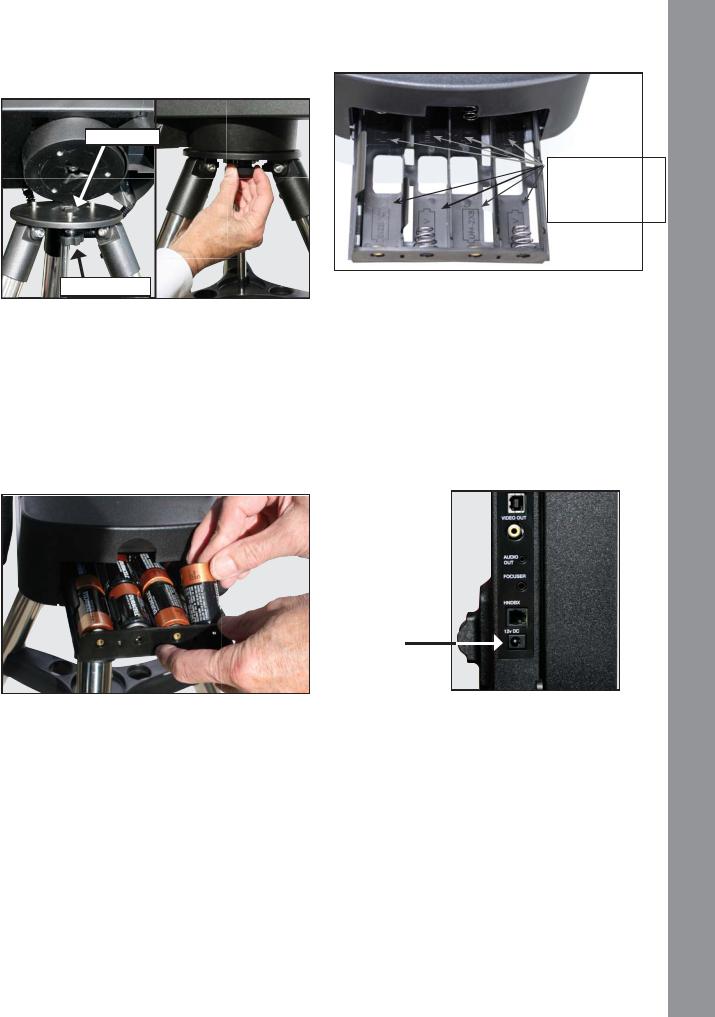
Mounting the Telescope
Center Hub
Thumb-Screw
Take the LS Telescope from its packaging and place the entire telescope onto the top of the tripod head. Rotate the telescope head slowly until you feel the scope register on the center hub of the tripod head. Carefully screw the three attachment thumb-screws on the bottom of the plate to the base of the tripod. Hand tighten the screws so the telescope cannot spin or wobble on the tripod head.
Installing the Batteries
Remove the end cover from the battery compartment exposing the battery tray. Carefully slide the battery tray out until it reaches its end stop. Insert 8 (user supplied) Alkaline “C” batteries into the battery compartment. Take care that the batteries + and - ends are as indicated in the battery holder.
Slide the battery compartment back into the telescope and re-attach the battery compartment cover.
|
|
STARTED |
|
|
GETTING |
|
Follow the battery |
|
|
|
|
|
|
|
|
polarity (orientation) |
|
|
as indicated by |
|
|
molded icons |
|
CAUTION: Use care to install batteries as indicated by the battery compartment. Follow battery manufacturer’s precautions. Do not install batteries backwards or mix new and used batteries. Do not mix battery types. If these precautions are not followed, batteries may explode, catch fire, or leak. Improperly installed batteries void your Meade warranty. Always remove the batteries if they will not be used for a long period of time.
Using an AC Adapter or
DC Power Cord
Power
Port
Use only the optional Meade Universal AC Power |
|
|
Adapter (part number 07584 for North America or |
|
|
07584F for 220v foreign) with your LS telescope when |
|
|
connecting to AC power. It is specifically selected to |
|
|
provide the quality voltage and current required to |
|
|
power and protect the electronics in the telescope. |
|
|
Power adapters from other manufactures may cause |
|
|
damage and void your warranty. |
|
|
Plug the AC plug into a household AC socket |
|
|
and the DC plug into the 12v DC jack on the |
|
|
telescope panel. |
|
|
For external DC power use the optional #607 DC Power |
6 |
|
Cord (part number 07043) to connect to an automotive |
||
12v DC accessory socket. |
||
|
 INDEX
INDEX 

Attaching Accessories
Your Telescope is now Fully Assembled
Now remove the dust cover from the front of the telescope tube. Be careful not to touch the glass lens.
GETTING STARTED
Be sure the telescope master power switch is in the off position. Remove the AutoStar III handbox and the coiled interface cable from the packing materials. Plug one end into the HNDBX port of the control panel and plug the other end into the Handbox port on the AutoStar III handbox.
Rear Cell Thread |
|
Eyepiece Holder |
Dust Cap |
|
Diagonal Prism |
Remove the dust cap from the rear cell of the telescope. Thread the 1.25" eyepiece holder onto the rear cell thread. Slide the diagonal prism into the eyepiece holder and lock in place by turning the thumbscrew to a firm feel. Place the Super Plössl 26mm eyepiece into the diagonal prism and tighten the diagonal prism thumbscrew to a firm feel only.
Next remove the dust cap from the ECLIPS CCD Module and put it in a safe place.
Powering Up The Telescope
When night has fallen, approximately 1 hour after sunset, turn on your telescope. Flip the LightSwitch on the telescope fork arm to the ON (1) position. The copyright message lights on LS’s LCD display.
7
 INDEX
INDEX 
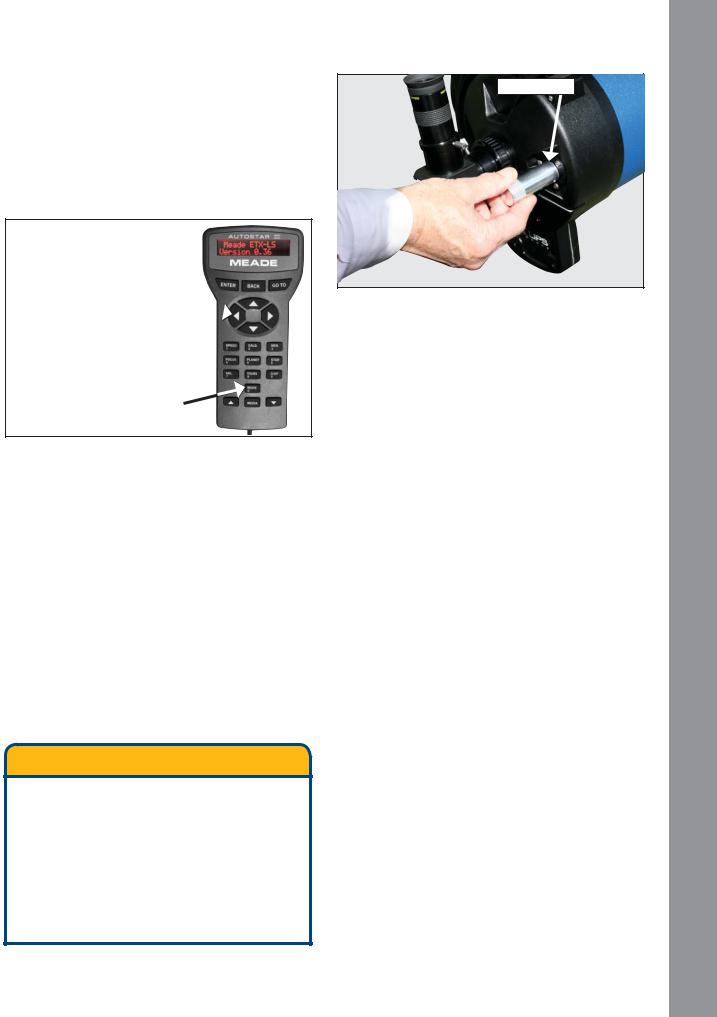
After the telescope powers on, you will hear a brief introductory message. You can press the “MEDIA” key to bypass the introduction if you like.
If you have attached a video cable from the Video Out connection on the telescope to the composite video input of a NTSC TV monitor, you will also see graphics accompanying the telescope introduction.
Slew Speeds:
Speed 9: Fast
'Arrow
'Keys 
Speed 5: Medium
'
'
Speed 1: Slow
Number
Keys
At the end of this message, the telescope will immediately start its LightSwitch Automatic Alignment procedure. It will take about five to ten minutes for the telescope to orient and align itself. Once it has completed the alignment the handbox screen will display “Alignment Successful”.
LS TIPS
“MODE” Key
The “MODE” Key cycles the telescope through its three different modes; Menu Mode, Info Mode and Skymap Mode.
During most telescope operations, pressing the “MODE” key will stop the current operation.
Focus Knob
At this point look through the eyepiece of the telescope. You should see some light from the final alignment star but it is probably out of focus. Adjust the focus using the knob on the back of the telescope until you get a sharply focused star image.
Press the “Tours/8” key on theAutoStar and select the “Tonight’s Best” tour by pressing the Scroll Down arrow key at the bottom of theAutoStar. Press “ENTER” to start the tour of the best objects visible in your sky right now. You will hear a brief introduction to the tour and then the first object will be shown on the second line of the AutoStar display. If you press “ENTER” to select this object, you will hear a description of the object. If you press the GoTo key, the telescope will move (slew) to put the object in the eyepiece so you can view it directly. To move to the next object, press the “BACK” key and then the Scroll Down key to move through the available objects in the tour. Press “ENTER” to select the displayed object. To exit the tour, press the “Mode” key.
When you are finished observing for the night, replace the dust cover over the end of the telescope and the dust cap on the lens of the ECLIPS Module. Select “Shutdown” from the main top level menu. After the telescope has moved to its storage position and the AutoStar displays “Turn Off Telescope”, flip the LightSwitch to the OFF (0) position.
GETTING STARTED
8
 INDEX
INDEX 
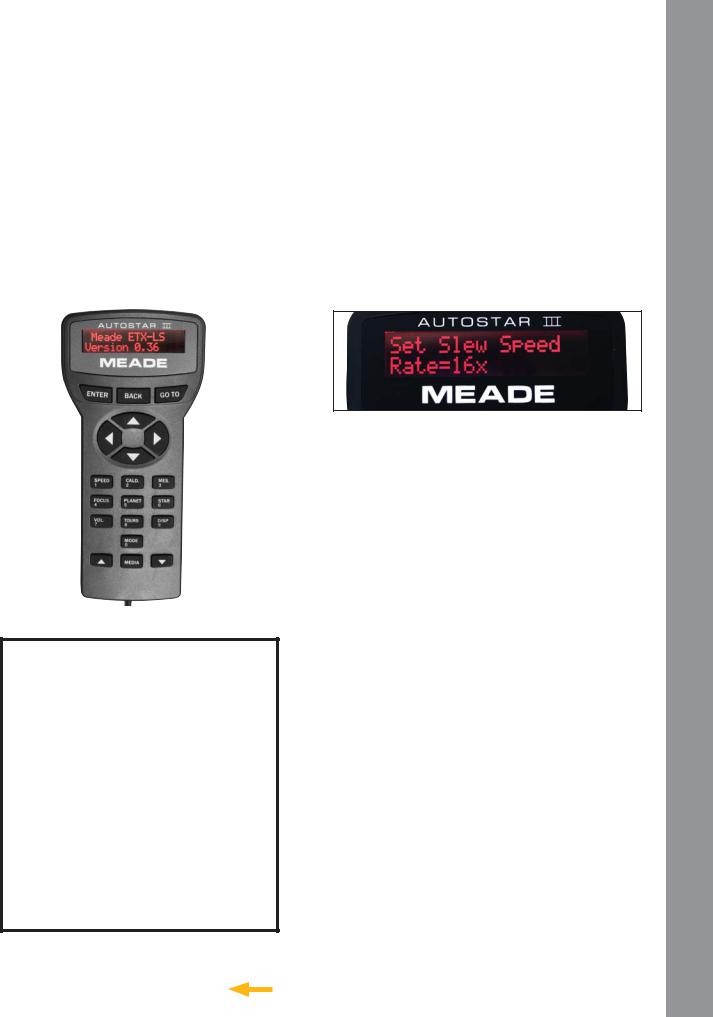
AUTOSTAR III HANDBOX –
BASIC USAGE
Now that you have successfully setup and used your LS telescope, it’s time for more information about all the capabilities of this amazing optical system.
The first step is to familiarize yourself with the AutoStar III handbox operation. The largest keys on the keypad are the motion control keys. Most of the time, these keys allow you to move, or slew, your telescope both up and down and right and left. Press them now and see how the telescope moves in response to the keys. When the telescope initially starts up the scope is set to move at its fastest speed. While this is great for getting close to the area you want to see, it is really too fast to get anything positioned into the eyepiece. For that reason, the LS has 9 distinct speeds.
AUTOSTAR III BASIC USAGE
Key Functions
“BACK” - return to previous menu. “ENTER” - select or confirm entry.
“GO TO” - Slew to currently selected object. “SPEED” - Adjust Slew Speed.
“FOCUS” - Optional Electronic focuser. Motion pad controls focuser.
Up/Down scrolls focus speed. “VOL”. - Up/Dn adjusts media
volume.
“DISP” - Control Display contrast, brightness.
“MODE” - Cycles thru Menu -> Scope info -> SkyMap -> Menu and aborts current operation.
“MEDIA” - Toggles media on and off. “CALD” - Lookup Caldwell Objects “MES” - Look up Messier Objects “PLANETS” - Look up planets in our
solar system “STAR” - Look up bright stars
To change the telescope’s speed, press the 1/SPEED key. You can now select a speed with the scroll up and down small arrow keys on the bottom of the hand control. When you have the desired speed selected, press the “ENTER” key. Alternatively, when the speed selection screen is showing, you can just press a number 1-9 to select a speed quickly, where 1 is the slowest and 9 is the fastest.
Take a moment and try move the scope around at some different speeds.
Navigating the Menus
Now that you are starting to get comfortable with the basics, lets learn some new keys. The most important keys for navigating the menus on you telescope are the keys along the top and bottom rows of your AutoStar. The two small arrows on the bottom of the key pad, allow you to scroll through the possible menu selections. The menu line is at the top of the handbox display and the top of the video monitor if connected. The second line of the hand control display has the current active menu item. If you are looking at a connected video display, you will see more menu choices and the active selection will be highlighted.
9
INDEX 

The “ENTER” and “BACK” buttons on the top of the display let you move up and down the menu tree. When you press “ENTER” you will select the current active menu choice. Pressing “BACK” will move you up the menu tree. To get us to the top of the menu tree, press “BACK” until “Select Item” is displayed on line 1 of the display. This is the top level menu. Use the scroll keys to navigate through the choices until you find “Objects”. Press “ENTER”. Now you should be able to navigate to “Constellations”. Once you are there press “ENTER” again. Now press “ENTER” to select “Andromeda”.
The telescope will now start to tell you the story of Andromeda. You can listen to the whole story, or press the “MEDIA” key to skip the story and more menu choices will appear. If you want to go from the menu, “BACK” to the story, just press the “MEDIA” key again to restart the story.
A complete tree of the available menu choice is contained in figure 6 on page 23 of the manual.
CHANGING MODES
Menu Mode
Up till now we have been exploring the Menu Mode. The handbox has several other modes in addition to simple menu navigation. You will notice the “0” key is also labelled “MODE”. Pressing “MODE” allows you to cycle through the telescopes three modes.
Scope Info Mode
Press “MODE” now. In Scope Info Mode the scroll keys allow you to look at the current time, date, and location where the telescope is pointing along with other key values about the status of your telescope.
Sky Map Mode
Press “MODE” again. The hand control display will show “Sky Map FOV=45”. In sky map mode an attached video monitor shows a planetarium-like map of the sky in the area where your telescope is pointed. Use the motion keys to move the scope and notice how the sky display changes as you move the scope. You can zoom the display in or out by pressing the scroll up and scroll down buttons.
Shortcuts!
Now lets look at the numeric keypad. Each of the number keys does two things. If the telescope is requesting input, the number keys allow you to enter digits into the telescope. When you are navigating the menus they act as shortcuts. Their assignments are as follows:
1.“SPEED”: We have already used this key. It
allows you to change the slew speed of the telescope.
2.“CALDWELL”: Let’s you look up members of a popular group of bright deep sky objects that make up the Caldwell Catalog.
3.“MESSIER”: Let’s you look up some of the most famous bright deep sky objects that make up the Messier Catalog
4.“FOCUS”: If you have the optional electric focuser on you your telescope you can press this key to go to focus mode. Now the arrow keys will move the focus in or out.
5. |
“PLANETS”: Lets you directly lookup |
|
a planet. |
6. |
“STARS”: Lets you directly lookup a |
|
bright stars. |
7.“VOLUME”: Gives you quick access to the telescope audio volume control
8.“TOURS”: Lets you directly select a guided tour.
(note: to exit a tour at any time hit the
“MODE” Key.)
Now spend a little quality time with the telescope to get comfortable navigating its features. When you a comfortable, it is time to go out and explore the night sky.
AUTOSTAR III BASIC USAGE
10
 INDEX
INDEX 
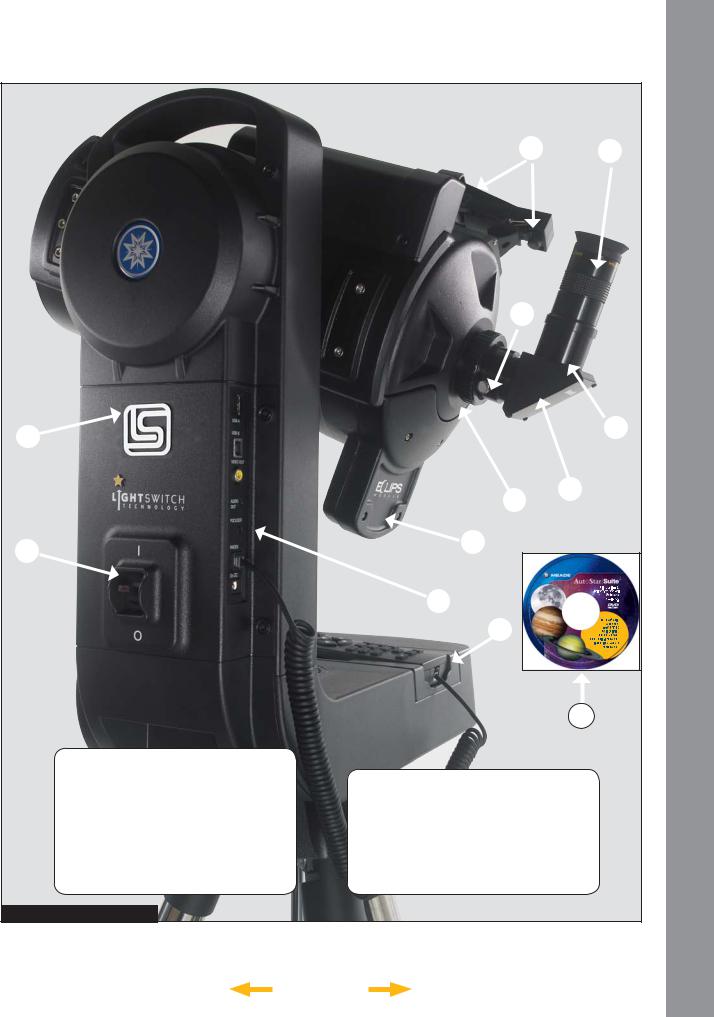
LS KEY FEATURES |
|
FEATURES |
|
|
|
|
|
|
|
|
LS KEY |
|
|
|
|
|
|
|
|
|
|
|
|
|
|
|
|
|
|
|
|
|
|
|
|
|
|
|
|
|
|
|
|
|
2& |
|
|
Diagonal Eyepiece Holder |
|
|
|
Diagonal Prism |
Telescope Input/Output Panel |
|
|
1.25” Eyepiece Holder |
ON/OFF LightSwitch |
|
|
Eyepiece Holder Thumb Screw |
ECLIPS CCD Module |
|
|
Eyepiece |
Red Dot Finder Alignment Screws |
|
|
Single Fork Arm Mount |
Handbox Storage Cradle |
|
|
Figure 1: LS Telescope |
|
|
|
|
|
|
11 |
|
INDEX |
|
|
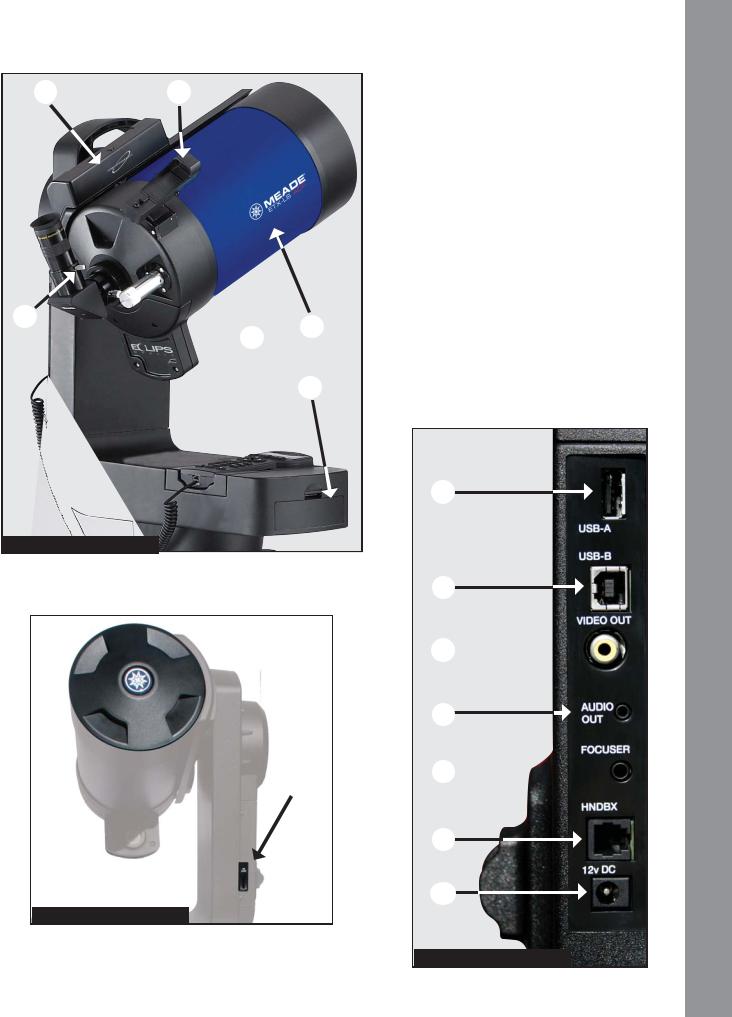

2!
2@
2# 2$ 2% 2^
Diagonal Thumbscrew Optical Tube Assembly (OTA) Focus Knob
Integrated Sensor Module Dust Cover
Battery Compartment Red Dot Finder
Mini SD Card Slot
USB-A for Future Expansion USB-B connector to PC Video Output
Audio Output Electronic Focuser Jack Handbox (HNDBX) Port 12v Power Input
Figure 2: LS Right Side
2!
 2@
2@
2#
2$

2%
2^
Figure 3: LS Front
Figure 4: LS Connectors
LS KEY FEATURES
12
 INDEX
INDEX 
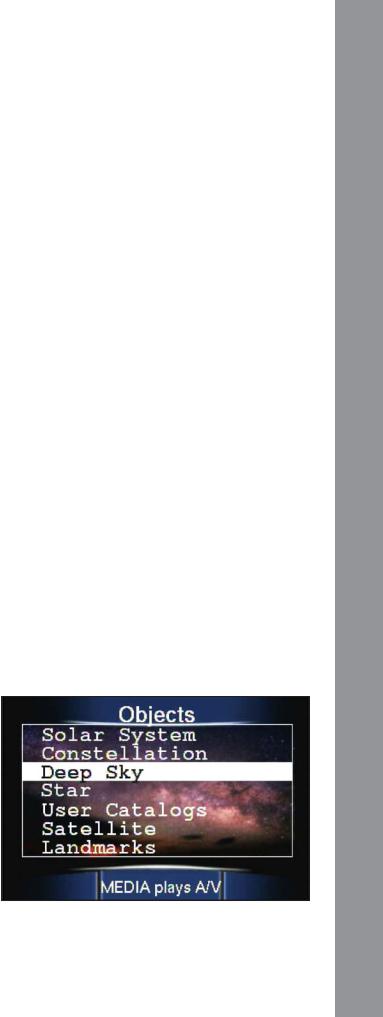
Diagonal Holder: Holds the eyepiece in place.
Diagonal Prism: provides a more comfortable right angle viewing position. Slide the diagonal prism directly into the eyepiece holder (Fig. 1, 3).
1.25" Eyepiece Holder
Eyepiece Holder Thumb Screw
Eyepiece: Place the Super Plössl 26mm eyepiece into the 90° diagonal prism (Fig. 1, 4) and tighten in place with the thumbscrews. The eyepiece magnifies the image collected in the optical tube.
Diagonal Eyepiece Holder Thumbscrew:
Tightens the eyepiece in place. Tighten to a firm feel only.
Optical Tube Assembly (OTA): The main optical component that gathers the light from distant objects and brings this light to a focus for examination through the eyepiece.
Single Fork Arm Mount: Holds the optical tube in place and moves it to find and track objects.
Focus Knob: Moves the telescope’s primary mirror in a finely-controlled motion to achieve precise image focus. The LS telescope can be focused on objects from a distance of about 25 ft. to infinity. Rotate the focus knob counterclockwise to focus on distant objects, and clockwise to focus on nearby objects.
Integrated Sensor Module: Receives location and time information transmitted from Global Positioning System (GPS) satellites. Determines north and level positions.
Telescope Input/Output Panel
Dust Cover: Gently lift out the dust cover from the front lens of the telescope. The dust cover should be replaced after each observing session and the power turned off to the telescope. Verify that any dew that might have collected during the observing session has evaporated prior to replacing the dust cover.
ON/OFF LightSwitch: Turns the LS system ON or OFF. The red LED power indicator light illuminates when power is on.
Battery Compartment: Insert eight ANSI 14A (IEC LR14) Alkaline “C-Cell” (user-supplied) batteries in compartment. Be sure batteries are aligned correctly as shown in the battery compartment.
ECLIPS CCD Module: The integrated camera is part of the system that allows the telescope to align itself, and provides you with a wide field imager when a video monitor is attached to your telescope.
Red Dot Finder: Provides an easy way to sight on objects and put them in the telescope’s eyepiece.
Red Dot Finder Alignment Screws: Adjust these screws to align the Red Dot Finder with the telescope’s main optics. See page 15 for more information.
Handbox Storage Cradle: Holds the AutoStar handbox in a convenient position on the telescope.
Mini SD Card Slot: Allows standard Mini-SD™ cards to be used to store images taken with the telescope. Can also be used to update the application firmware in the telescope.
USB-A Connector for future expansion
2! USB-B Connector to PC: Connects your telescope to a PC computer, so that the telescope can be remotely controlled from AutoStar Suite software, or other computer planetarium programs. This port can also be used to update the software in your telescope, manage custom catalogs, keep data on satellites, comets and asteroids current, and to download new tours to your telescope.
2@ Video Output: This connector allows you to connect the telescope to a NTSC television monitor (not supplied). This monitor will display:
a.Multiple line menus.
 INDEX
INDEX 
LS KEY FEATURES
13
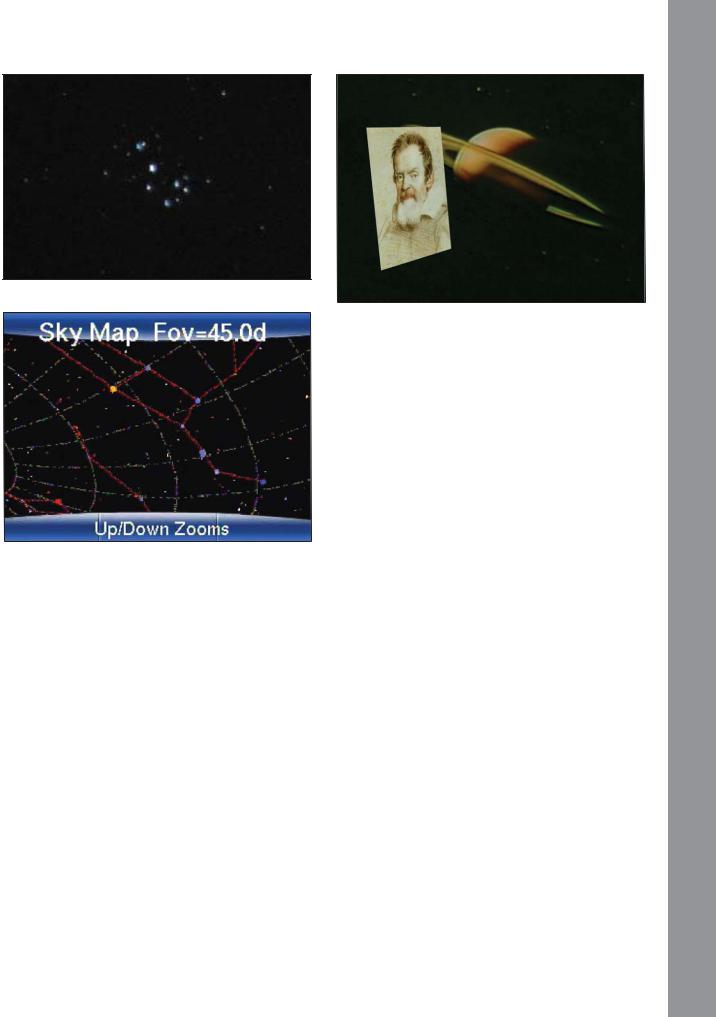
b.Images from the ECLIPS camera.
c.Sky maps of the region where your telescope is pointed
LS KEY FEATURES
d.Astronomer Inside videos and images of the moon, planets, and deep sky objects
e.The Video Output can be toggled on/off with the 9/DISP key.
2# Audio Output: This connection will allow you to pass the telescope’s stereo sound to external speakers, headphones or and external television monitor.
2$ Electronic Focuser Jack: Plug in the optional Meade Zero Image Shift Micro-Focuser (P/N 07080) for precision focusing control.
2% Handbox (HNDBX) Port: Plug the AutoStar III coil cord (Page 12, Fig. 4, 23) into this port.
2^ 12v Power Connector: Provides connection so that the telescope system may be powered from either a 12v DC auto cigarette light plug or from a standard 115v AC home outlet using the optional Meade Universal Power Adaptor. It is important that only the Meade Universal Power Adaptor be used to power the telescope.
2& AutoStar Suite Software: Contains the LS Instruction Manual and a collection of useful software including a planetarium program, the AutoStar Updater for downloading and upgrading the firmware in the telescope, software to control the telescope from a computer and other programs all designed to enhance your use of the LS system.
14
 INDEX
INDEX 
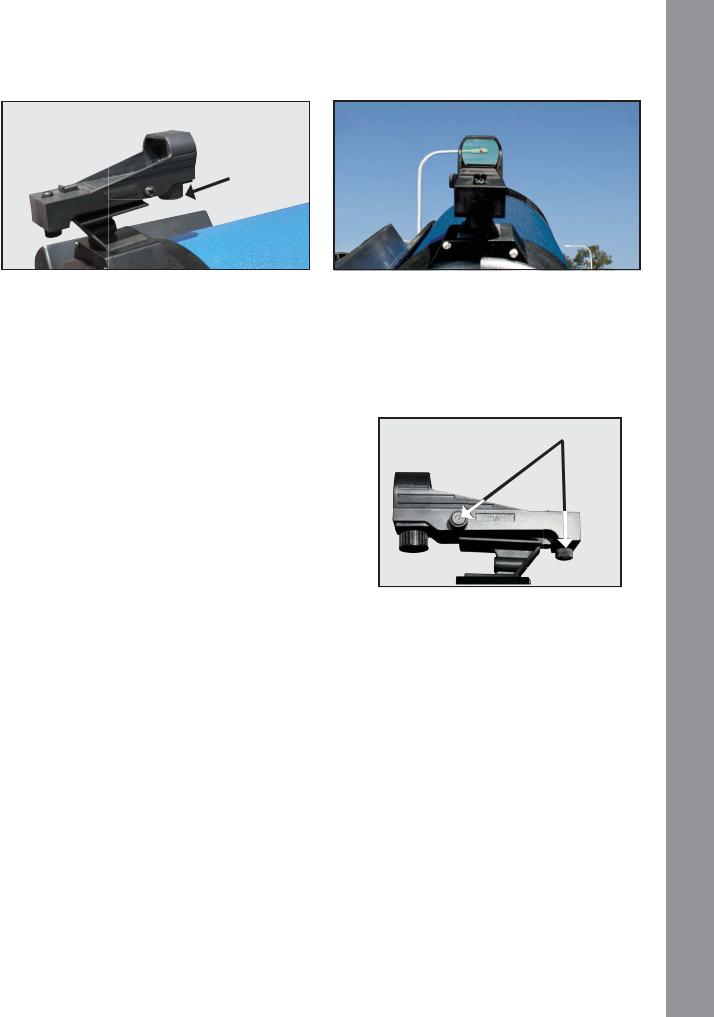
Using the Red-Dot Finder |
Adjusting the Red-Dot Finder |
On/Off &
Brightness
Adjustment
Because your telescope has so much magnification, its field of view is very small. This can make it hard to know exactly where your telescope is pointing by simply looking at it. To help you point the telescope quickly and accurately, for terrestrial targets or when not using Auto Alignment and GO TO pointing, the LS has a 1X Red-Dot Viewfinder.
The Red-Dot Finder will aid you in pointing your telescope easily. It works much like a fighter pilot’s heads-up display. To turn on the Red Dot Finder, carefully rotate the power switch until you feel it click on. Turning further clockwise will increase the dot brightness. Adjust the dot to the minimum brightness where it can be easily seen. This will extend its battery life and make it easier to see faint stars in the background. Look through the finder’s glass window. You will see a red dot superimposed on your view. Using the direction keys on the handbox, move the telescope until the red dot is on the target you want to view in the eyepiece. As you get close to your target, select a moderately low speed, like speed 5, and move the scope to center your target as you look through the eyepiece. This a great way to get used to finding the movement keys without removing your eye from the eyepiece.
The Red-Dot Finder has been aligned at the factory, but you may need to touch-up the alignment from time to time. To do this, look through the eyepiece of your scope and using the hand controller center a distant object. Now turn on the Red-Dot Viewfinder and adjust the brightness so you can see the red dot. Look through the sight as pictured above.
Adjustment
Screws
Now, without moving the telescope, adjust the indicated thumb screws until you have put the red dot on the object at which you were looking. It’s that simple.
Now use the hand controller to put the laser dot on a new target. Check to see that the desired target is in the eyepiece.
LS KEY FEATURES
15
 INDEX
INDEX 
